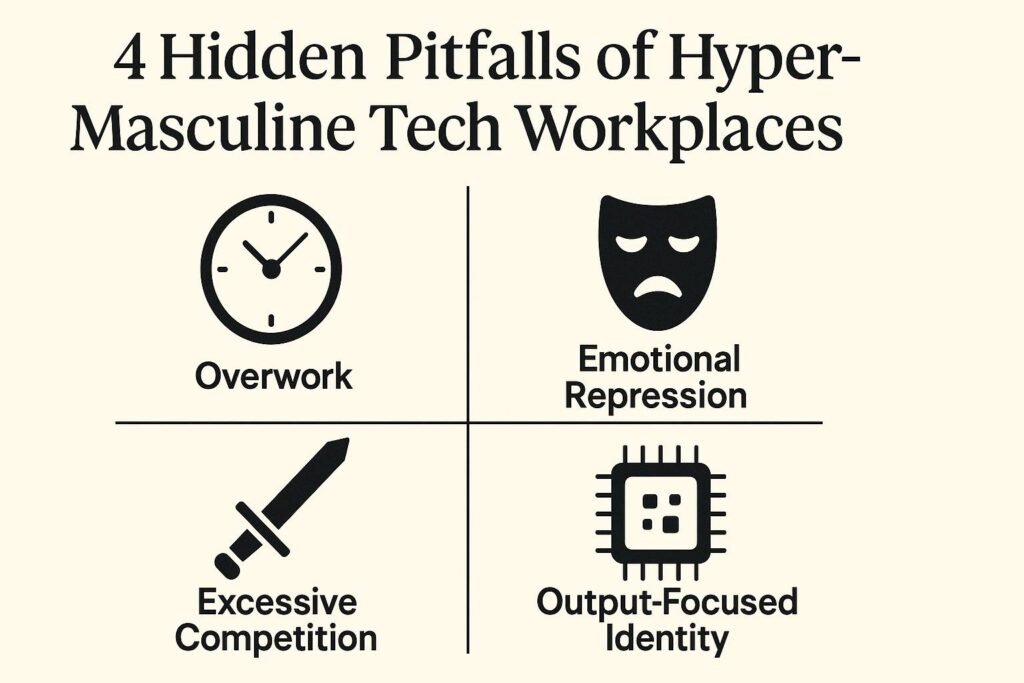INTRODUCTION
Hyper-masculine tech workplaces might look like they’re optimised for speed and performance, but beneath the sleek exterior, cracks often form. What happens when masculinity goes unchecked in the tech world? It starts subtly. A glorified all-nighter. A culture that rewards emotional detachment. Deadlines chased harder than health. At first, it looks like high performance, but dig deeper, and you’ll find something more fragile than fast: burnout, disconnection, and hidden tension under the surface of speed.
This article explores the overlooked ways hyper-masculine norms, when left to run wild in tech workplaces, can quietly sabotage not only your team’s energy but also your long-term effectiveness as a man in leadership.
Tech is fast. Tech is aggressive. Tech is male-dominated. And while that raw, builder’s energy can spark innovation and speed, it can also hide traps beneath the surface, especially when hyper-masculine culture takes the wheel. What looks like “drive” often masks burnout. What feels like “focus” might just be emotional suppression. In this article, we uncover four overlooked ways that hyper-masculine dynamics quietly erode clarity, collaboration, and long-term performance.
Table of Contents
Why This Matters
Hyper-masculine tech workplaces may appear productive and intense on the surface, but that intensity often hides a serious blind spot: the inability to deal with the human side of work. In these environments, silence is seen as strength, emotional expression as a liability, and burnout as some sort of elite badge of honour (as if falling asleep on your keyboard at 2 AM means you’re a visionary).
The tech world often celebrates the lone wolf hacker, the 80-hour workweek warrior, and the emotionless optimiser who treats life like code. But here’s the uncomfortable truth: workplaces saturated in hyper-masculine energy often suffer from toxic communication, stunted leadership, and chronic disconnection.
According to a 2023 Deloitte report, over 61% of male employees in tech say they feel uncomfortable expressing emotional stress or personal challenges at work. That discomfort becomes dysfunction. That dysfunction then gets rebranded as “grit.” And before you know it, you’ve got teams who can ship code faster than anyone, yet can’t even recognise when someone on Slack is quietly unravelling. “2023 Deloitte report”
If hyper-masculine tech workplaces don’t evolve, they risk becoming fast-moving but emotionally bankrupt cultures, where innovation gets done, but nobody feels safe enough to say what’s really going wrong.
Let’s call it what it is: leadership theatre in performance-optimised silence. And it’s hurting more than just your next sprint.

Pitfall 1: “Always On” Becomes Default Survival Mode
It starts with a well-meaning push: “Let’s ship faster.” Then suddenly, it’s 10 PM, and Slack is still buzzing like a caffeinated swarm. In hyper-masculine tech workplaces, the idea of being “always available” turns from a badge of dedication into a silent expectation, until it becomes the air everyone breathes and no one questions. Burnout isn’t just tolerated; it’s practically baked into the culture.
This pitfall glorifies productivity to the point of absurdity. The line between “ambitious” and “chronically anxious” gets blurred. Coworkers compare sleep deprivation like it’s a sport. Time off becomes guilt-ridden. And the rest? That’s for the weak, or so the culture implies.
The dark joke? The more these environments push speed, the sloppier the output gets. But by the time people admit it, the team is fried and the product is buggy. Not exactly the MVP anyone envisioned.
What it is:
The glorification of hustle, where rest is shameful and productivity equals worth.
Why it matters:
Chronic overwork doesn’t mean you’re winning. It often signals poor boundaries, poor leadership modelling, or unresolved anxiety being masked as ambition.
How it applies to hyper-masculine tech workplaces:
This “always-on” mindset becomes a badge of honour. But beneath it is a nervous system fried by Slack pings and a body deprived of circadian rhythm. Focus becomes fragmented, and decisions become reactive.
Example:
You celebrate the engineer who pulls 16-hour days but silently ignore his rising error rate, mood swings, and inability to collaborate.
Pitfall 2: Emotional Detachment Masquerades as Logic
In hyper-masculine tech workplaces, the highest praise often goes to the person who never blinks, never flinches, and never admits when they’re drowning. Emotional detachment is framed as professionalism. But let’s be honest: it’s just repression with better branding.
You’ll hear things like “Don’t take it personally” or “Keep it objective” thrown around like spiritual mantras. But in reality, detachment isn’t neutrality, it’s disconnection. The kind that erodes empathy, builds silent resentment, and eventually implodes culture. It’s the emotional equivalent of shipping code with zero testing and hoping the customer never notices.
Logic matters, yes. But so does emotional literacy, the ability to read a room, hear what’s not being said, and sense when someone’s “I’m fine” actually means “I’m one sprint away from quitting.”
Spoiler alert: the best leaders aren’t cold, they’re clear. And clarity includes emotion. It doesn’t drown in it, but it doesn’t delete it either.
What it is:
The idea that “feelings are inefficient” and decisions should be made in a vacuum of stoicism.
Why it matters:
Emotional intelligence isn’t a weakness. It’s a multiplier of trust, leadership, and team coherence.
How it applies to hyper-masculine tech workplaces:
You get meetings that are efficient but cold. Feedback that is blunt but demotivating. Managers who optimise dashboards but can’t sense team morale until it’s too late.
Example:
A product lead shrugs off burnout in their team because “metrics are green.” Until they’re not, and three developers suddenly resign.
Pitfall 3: Competition Cripples Collaboration
In hyper-masculine tech workplaces, it’s not enough to be good; you have to be better than the guy next to you. But when competition becomes the air you breathe, collaboration suffocates. What starts as healthy performance pressure can morph into territorialism, intellectual hoarding, and ego-driven decisions that tank team momentum.
This kind of culture rewards the loudest opinion, not the most thoughtful. It values solo wins over shared success. And ironically, it breeds underperformance in disguise, because while one person shines, the system suffers.
Here’s the kicker: collaboration isn’t a soft skill; it’s a survival skill in modern tech. Products are complex. Systems are interdependent. And if engineers treat knowledge like currency instead of contribution, your codebase ends up bloated, brittle, and filled with duplicated effort just because nobody wanted to “lose points” by asking for input.
It’s not just inefficient, it’s exhausting. And in the long run, no one wins the race when the track is on fire.
What it is:
Hyper-individualism that celebrates winning, even if it means the team loses.
Why it matters:
The best tech is built in teams. Lone genius stories are romanticised, but real innovation is always collaborative.
How it applies to hyper-masculine tech workplaces:
Men overcompensate by being territorial, withholding ideas, or resisting cross-functional efforts. Trust erodes. Psychological safety dies.
Example:
You’ve got engineers optimising their own code for performance benchmarks, but no one is reviewing each other’s work. Ego wins. The product suffers.
Pitfall 4: Identity Gets Tied to Output
In hyper-masculine tech workplaces, productivity becomes a personality type. You’re not just a developer, you’re a deliverables machine. The question “What have you shipped lately?” replaces “How are you holding up?” and before long, your sense of worth lives and dies by your Jira board.
When output becomes identity, any delay feels like personal failure. Taking a break feels like weakness. And asking for help? That’s practically a confession that you’ve lost your edge. This pitfall doesn’t just burn people out; it isolates them in their own silent performance pressure.
The irony? The more you define yourself by what you produce, the more brittle your confidence becomes. One failed deployment or one missed sprint, and the inner monologue turns brutal. Men in these environments don’t just fear being unproductive; they fear being unseen.
And no one does their best work when their self-worth is hanging by a Git commit.
What it is:
When self-worth becomes dependent on speed, deliverables, and perceived “value creation.”
Why it matters:
This leads to identity collapse during setbacks, perfectionism paralysis, and constant anxiety. Men don’t ask for help because slowing down feels like erasure.
How it applies to hyper-masculine tech workplaces:
Failure is hidden. Vulnerability is punished. The result? Burnout masked as busyness, and disengagement hidden behind “I’m fine.”
Example:
The senior dev who can’t admit he needs mentorship, so he over-engineers for weeks in isolation, rather than pair-program for 30 minutes.
Conclusion
Hyper-masculine energy isn’t inherently bad. It builds things. It protects. It drives momentum. But left unchecked in tech culture, it becomes a performance mask that disconnects us from what makes great work sustainable: clarity, trust, rest, and presence.
If you want to lead in tech, lead differently. Reclaim grounded masculine presence that includes emotional fluency, boundaries, and collaborative strength.

→ Want more? Read: [3 Brutal Truths About Masculine Culture in US Offices] or explore [The Masculine Discipline System] to build balance without burnout.
Suggested Articles
1. 3 Brutal Truths About Masculine Culture in US Offices
Explore how office dynamics reward and punish masculine traits, and what it means for your leadership and focus.
2. The Masculine Discipline System: Daily Structure for Mental Sharpness
Learn how structure, rhythm, and simple rituals can help you build clarity and protect your energy from burnout.
3. How to Build Unshakable Focus as a Man in a Distracted World
If hyper-masculine culture scatters your attention, this guide helps you rebuild mental command without noise.
4. Discipline Over Motivation: A Masculine Framework That Actually Works
Forget hype. Here’s how grounded masculine men stay consistent and sharp, even when energy and inspiration fade.
5. The Daily Testosterone System: Sleep, Light, and Movement Aligned
The tech grind often destroys hormones., This article gives you a system to realign your biology and energy naturally.


